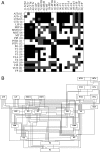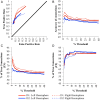Validation of High-Resolution Tractography Against In Vivo Tracing in the Macaque Visual Cortex
- PMID: 25787833
- PMCID: PMC4816782
- DOI: 10.1093/cercor/bhu326
Validation of High-Resolution Tractography Against In Vivo Tracing in the Macaque Visual Cortex
Abstract
Diffusion magnetic resonance imaging (MRI) allows for the noninvasive in vivo examination of anatomical connections in the human brain, which has an important role in understanding brain function. Validation of this technique is vital, but has proved difficult due to the lack of an adequate gold standard. In this work, the macaque visual system was used as a model as an extensive body of literature of in vivo and postmortem tracer studies has established a detailed understanding of the underlying connections. We performed probabilistic tractography on high angular resolution diffusion imaging data of 2 ex vivo, in vitro macaque brains. Comparisons were made between identified connections at different thresholds of probabilistic connection "strength," and with various tracking optimization strategies previously proposed in the literature, and known connections from the detailed visual system wiring map described by Felleman and Van Essen (1991; FVE91). On average, 74% of connections that were identified by FVE91 were reproduced by performing the most successfully optimized probabilistic diffusion MRI tractography. Further comparison with the results of a more recent tracer study ( Markov et al. 2012) suggests that the fidelity of tractography in estimating the presence or absence of interareal connections may be greater than this.
Keywords: diffusion imaging; macaque; tractography; validation; visual cortex.
© The Author 2015. Published by Oxford University Press.
Figures






References
-
- Abe O, Masutani Y, Aoki S, Yamasue H, Yamada H, Kasai K, Mori H, Hayashi N, Masumoto T, Ohtomo K. 2004. Topography of the human corpus callosum using diffusion tensor tractography. J Comput Assist Tomogr. 284:533–539. - PubMed
-
- Abramoff MD, Magalhaes PJ, Ram SJ. 2004. Image processing with Image. J Biophotonics Int. 117:36–42.
-
- Alexander DC. 2005. Multiple-fiber reconstruction algorithms for diffusion MRI. Ann N Y Acad Sci. 10641:113–133. - PubMed
Publication types
MeSH terms
Grants and funding
LinkOut - more resources
Full Text Sources
Other Literature Sources

